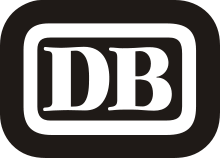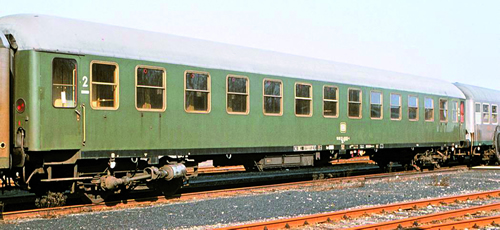Model Information: Introduced in 1968 as the first N scale Passenger car of Lima in its Italian Az version, this body style was then used for several other European road names up until the early 1980's.
With a length of 138mm, this car is shorter than the UIC-Y prototype; it should be 153 mm at N scale (1/160) to be prototypically correct.
It features 9 compartment windows like the UIC-Y prototype for 1st class, however this body style has also be used until 1978 for german DB A4üm cars that would in fact be of the UIC-X type with 10 compartment windows for 1st class.
For a short period of time after 1968, this body style has also been used repainted with North American paint schemes, until Lima introduced more prototypically correct body styles of North American Passenger cars.
With a length of 138mm, this car is shorter than the UIC-Y prototype; it should be 153 mm at N scale (1/160) to be prototypically correct.
It features 9 compartment windows like the UIC-Y prototype for 1st class, however this body style has also be used until 1978 for german DB A4üm cars that would in fact be of the UIC-X type with 10 compartment windows for 1st class.
For a short period of time after 1968, this body style has also been used repainted with North American paint schemes, until Lima introduced more prototypically correct body styles of North American Passenger cars.
Prototype History: The UIC (Union International des Chemins de fer) type X is a type of passenger car defined in 1961 by UIC bulletin 567, together with UIC type Y. They have been standardized based on the design introduced after WWII by the Deutsche Bundesbahn (DB) for its express cars, that was known as üm-Wagen or m-Wagen. The length of the UIC-X cars was the longest of all passenger cars built until then; this length has been kept identical for the UIC-Z type introduced in the 1970's.
Several thousands of these cars have been built for the major western European railways: Germany (DB), Italy (FS), Spain (RENFE), Switzerland (SBB-CFF-FFS), Austria (ÖBB)
From Wikipedia (in French)
See also these detailed articles (in Italian) for more information about both the prototypes and the N scale models: UIC-X.
Several thousands of these cars have been built for the major western European railways: Germany (DB), Italy (FS), Spain (RENFE), Switzerland (SBB-CFF-FFS), Austria (ÖBB)
- Deutsche Bundesbahn (DB) : a total of 6,145 UIC-X cars in 3 series (53, 61, 63) of various types - Am (1st class), ABm (1st/2nd class), Bm (2nd class), Bcm (sleeper), BDms (Baggage), ARm (1st class diner) et BRbumh (2nd class diner/bar) - more details (in German) on Wikipedia
- Ferrovie dello Stato (FS): a total of 4,746 UIC-X cars in 7 series (64, 66-68, 68, 70, 75, 79-82) of various types - A (1st class), AB (1st/2nd class), B (2nd class), Bc (sleeper), AcBc (sleeper). And also ...
- 163 Railway Post office cars: UIz Type 1964 (20), UIz Type 1968 (30), UMIz Type 1970 (33), UMIz Type 1976 (80)
- 317 Baggage cars: Dz UIC-X 1968 (60), Dz UIC-X 1970 (77), Dz–D UIC-X 1975 & 1982 (93), nD UIC-X 1987 (80), D UIC-X 1982 GC (7)
- Spanish Railways (RENFE) - Serie 8000: a total of 883 UIC-X cars built between 1961 and 1973, of various types: 121 AA or A10r-8000 (1st class), 6 AAB or A5B5-8000 (1st/2nd class), 15 BB or B10r-8000 (2nd class), 445 BB or B12r-8500 (2nd class), 117 BBL or Bc10r-8100 (sleeper), 8 RRR or R8-8000 (diner), 90 DD or D8-8000 (Baggage), 62 DDT (Baggage), 25 DDET (Baggage/RPO)
- Federal Swiss Railways (SBB-CFF-FFS) : 40 Am (1st class), 20 ABm (1st/2nd class), 320 Bm (2nd class), 50 Bcm (sleeper), 10 WRm (diner), 20 Dms (Baggage)
- Austrian Railways (ÖBB): 90 Bcmz (sleeper, derived from the Swiss type)
From Wikipedia (in French)
See also these detailed articles (in Italian) for more information about both the prototypes and the N scale models: UIC-X.
Road Name History:  Deutsche Bundesbahn was the Western Germany DB before reunification. After World War II, Germany (and the DRG) was divided into 4 zones: US, British, French and Soviet. The first three eventually combined to form the Federal Republic of Germany (the West) and the Russian zone became the German Democratic Republic (the East). German territories beyond the Oder were ceded to Poland except for the northern part of East Prussia, which was ceded to the Soviet Union in 1945.
Deutsche Bundesbahn was the Western Germany DB before reunification. After World War II, Germany (and the DRG) was divided into 4 zones: US, British, French and Soviet. The first three eventually combined to form the Federal Republic of Germany (the West) and the Russian zone became the German Democratic Republic (the East). German territories beyond the Oder were ceded to Poland except for the northern part of East Prussia, which was ceded to the Soviet Union in 1945.
From 1949, the new governments assumed authority for railway operations. The DRG's (or DR's) successors were named Deutsche Bundesbahn (DB, German Federal Railways) in West Germany, and Deutsche Reichsbahn (DR, German State Railways) in East Germany kept the old name to hold tracking rights in western Berlin.
Unlike the DRG, which was a corporation, both the DB and the DR were federal state institutions, directly controlled by their respective transportation ministries. Railway service between East and West was restricted; there were around five well-controlled and secure checkpoints between West and East Germany, and about the same number between East Germany and West Berlin. Four transit routes existed between West Germany and West Berlin; citizens of West Berlin and West Germany were able to use these without too much harassment by the East German authorities.
The DB started in 1968 with changing the locomotive and passenger car serial numbers to the UIC norm. In 1970 the DR followed. The DB started experimenting with the Intercity trains in a new livery (bright orange).
In 1989, the Wall fell. Train frequency rapidly increased on the existing East/West corridors; closed links which had formerly crossed the border were re-opened. On 3 October 1990, Germany was reunified; however, this was not immediately the case with the railways. Administrative and organisational problems led to the decision to completely re-organize and reconnect Germany's railways. The so-called Bahnreform (Railway Reform) came into effect on 1 January 1994, when the State railways Deutsche Bundesbahn and Deutsche Reichsbahn were formally reunited to form the current German Railway Corporation (Deutsche Bahn).
From Wikipedia

From 1949, the new governments assumed authority for railway operations. The DRG's (or DR's) successors were named Deutsche Bundesbahn (DB, German Federal Railways) in West Germany, and Deutsche Reichsbahn (DR, German State Railways) in East Germany kept the old name to hold tracking rights in western Berlin.
Unlike the DRG, which was a corporation, both the DB and the DR were federal state institutions, directly controlled by their respective transportation ministries. Railway service between East and West was restricted; there were around five well-controlled and secure checkpoints between West and East Germany, and about the same number between East Germany and West Berlin. Four transit routes existed between West Germany and West Berlin; citizens of West Berlin and West Germany were able to use these without too much harassment by the East German authorities.
The DB started in 1968 with changing the locomotive and passenger car serial numbers to the UIC norm. In 1970 the DR followed. The DB started experimenting with the Intercity trains in a new livery (bright orange).
In 1989, the Wall fell. Train frequency rapidly increased on the existing East/West corridors; closed links which had formerly crossed the border were re-opened. On 3 October 1990, Germany was reunified; however, this was not immediately the case with the railways. Administrative and organisational problems led to the decision to completely re-organize and reconnect Germany's railways. The so-called Bahnreform (Railway Reform) came into effect on 1 January 1994, when the State railways Deutsche Bundesbahn and Deutsche Reichsbahn were formally reunited to form the current German Railway Corporation (Deutsche Bahn).
From Wikipedia
Brand/Importer Information: Lima N scale European models were numbered with 3 digits until 1978. They were renumbered after 1978 by adding "320" before the previous number. e.g. "306" became "320306".
Manufacturer Information:  Lima S.p.A (Lima Models) was a brand of railway models made in Vicenza, Italy, for almost 50 years, from the early 1950s until the company ceased trading in 2004. Lima was a popular, affordable brand of 00 gauge and N gauge model railway material in the UK, more detailed H0 and N gauge models in France, Germany, Italy, Switzerland, and the United States as well as South Africa, Scandinavia and Australia. Lima also produced a small range of 0 gauge models. Lima partnered with various distributors and manufacturers, selling under brands such as A.H.M., Model Power, Minitrain and PMI (Precision Models of Italy). Market pressures from superior Far Eastern produce in the mid-1990s led to Lima merging with Rivarossi, Arnold, and Jouef. Ultimately, these consolidations failed and operations ceased in 2004.
Lima S.p.A (Lima Models) was a brand of railway models made in Vicenza, Italy, for almost 50 years, from the early 1950s until the company ceased trading in 2004. Lima was a popular, affordable brand of 00 gauge and N gauge model railway material in the UK, more detailed H0 and N gauge models in France, Germany, Italy, Switzerland, and the United States as well as South Africa, Scandinavia and Australia. Lima also produced a small range of 0 gauge models. Lima partnered with various distributors and manufacturers, selling under brands such as A.H.M., Model Power, Minitrain and PMI (Precision Models of Italy). Market pressures from superior Far Eastern produce in the mid-1990s led to Lima merging with Rivarossi, Arnold, and Jouef. Ultimately, these consolidations failed and operations ceased in 2004.
Hornby Railways offered €8 million to acquire Lima's assets (including tooling, inventory, and the various brand names) in March of the same year, the Italian bankruptcy court of Brescia (town near Milan, last headquarters of Lima) approving the offer later that year. In December 2004, Hornby Railways formally announced the acquisition along with the Rivarossi (H0 North American and Italian prototypes), Arnold (N scale European prototypes), Jouef (H0 scale French prototypes), and Pocher (die-cast metal automobile kits) ranges. As of mid-2006, a range of these products has been made available under the Hornby International brand, refitted with NEM couplings and sprung buffers and sockets for DCC (Digital Command Control) decoders.
From Wikipedia

Hornby Railways offered €8 million to acquire Lima's assets (including tooling, inventory, and the various brand names) in March of the same year, the Italian bankruptcy court of Brescia (town near Milan, last headquarters of Lima) approving the offer later that year. In December 2004, Hornby Railways formally announced the acquisition along with the Rivarossi (H0 North American and Italian prototypes), Arnold (N scale European prototypes), Jouef (H0 scale French prototypes), and Pocher (die-cast metal automobile kits) ranges. As of mid-2006, a range of these products has been made available under the Hornby International brand, refitted with NEM couplings and sprung buffers and sockets for DCC (Digital Command Control) decoders.
From Wikipedia
Item created by: Alain LM on 2025-01-04 06:37:17. Last edited by Alain LM on 2025-01-04 07:51:50
If you see errors or missing data in this entry, please feel free to log in and edit it. Anyone with a Gmail account can log in instantly.
If you see errors or missing data in this entry, please feel free to log in and edit it. Anyone with a Gmail account can log in instantly.





